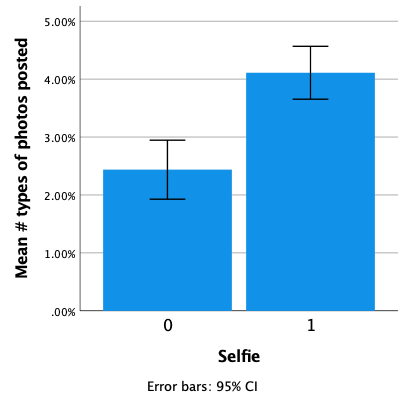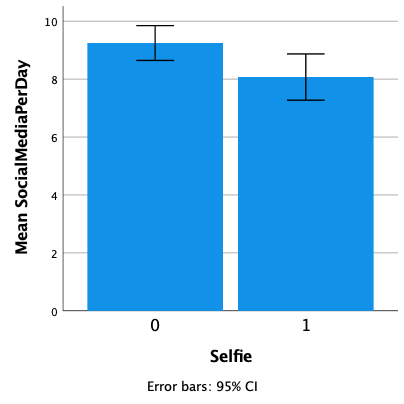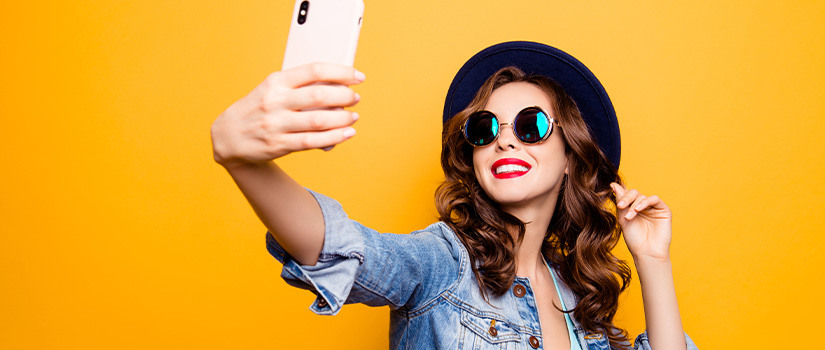Author
Cameryn Freglette
Mentor
Melanie Palomares, Ph.D.
Psychology 228 (Laboratory in Psychology) is a capstone class for psychology majors and minors. The main goal of the course is the completion of an independent research project, which the student develops themselves from idea to data analysis over the course of the semester. The instructional team is led by faculty member Dr. Melanie Palomares and dedicated graduate students. The 2019-2020 graduate student team consisted of Wendy Chu, Kristin Kirchner, Samantha Langley, Jaleel McNeil, Jonathan Rann, and Daria Thompson.
Students were encouraged to develop a study based on their personal interests such as social media, interpersonal relationships, or exercise. Following certification in human subjects training, the students collected data by deploying surveys and assessments to their target demographic. Students analyzed and interpreted their data using SPSS, a statistical software. Students then wrote a full length, APA style research paper about their project. Students from this class acquired several skills such as responsible research conduct, survey creation, statistical software analysis, and professional writing. This class provided the opportunity for undergraduate students to preview the graduate student research experience. The students published here went the extra mile and prepared their research papers for this publication, which often included additional, more sophisticated data analysis and new research questions.
Abstract
The objective of this study was to assess if narcissism can be predicted through social media behaviors such as frequency of posts, posting selfies, and social media presence on a variety of platforms. This study was conducted through a questionnaire related to social media use and a brief assessment from the Narcissistic Personality Inventory (NPI- 16). Results indicated that social media use per day was significantly different between people who post selfies and those who do not. Participants that scored higher for narcissism used social media less but posted significantly more selfies. Results were not significant in predicting narcissism through other social media behaviors tested. This data was consistent with recent literature linking narcissistic characteristics with selfie posting behaviors. With social media serving as a place for narcissists to achieve excessive admiration from others, it is logical to assess narcissism through social media. However, these results imply that narcissism cannot be determined solely through one’s behavior on social media. Perhaps social media behaviors are far more complex than hypothesized. Such behaviors that were hypothesized to be correlated with narcissism may be more strongly correlated to factors such as low self-esteem and attention seeking behavior. Further research will be needed to assess this.
Predicting Narcissism Through Social Media
With the growing nature of technology in today’s world, social media is present in many aspects of everyday life. In light of COVID-19, the reliance on technology is at an all-time high. Being able to gain knowledge of one’s personality through social media has significant advantages. From choosing your college roommate, to hiring someone for a job, or pursuing a relationship, being able to accurately assess someone through a social media page is a useful skill to have. In this study, we aim to explore the relationship between classic traits of narcissism and social media behaviors. Specifically, we aimed to correlate narcissism with the degree of social media usage such as posting selfies, posting on a variety of social media platforms, and how many days a week they post on social media.
Current literature is providing evidence to learn about one’s personality through social media. A recent example can be found in study conducted by Singh, Farley, and Donahue (2018) that assessed narcissism in relation to social media, through selfies specifically. The results indicated that people with higher levels of narcissism not only post more selfies on social media, but also view their selfies as more attractive, spend an increased amount of time on social media, and frequently use more than one social media platform. The research also revealed that the narcissists intention for posting selfies is for reasons related to having others show interest in them and receiving admiration. These are examples of self-interest motives that are classic of narcissists (Santokh et al., 2018). It would be logical that selfie posting specifically, would relate to narcissism due to the inflated perception of the narcissist and their attention seeking nature. Beyond this study, current literature indicates the complexity of narcissism and social media behaviors. Across the current literature, there have been found to be many other factors attributed to social media use besides narcissism alone.
One study considered factors such as depression, self-esteem, BMI, appearance comparison, and dietary constraint to be associated with social media behaviors (Rodgers et al., 2020). This study was similarly done through a questionnaire assessing for narcissistic traits and questions pertaining to social media habits. Results found that social media use was only weakly correlated to low self-esteem; however, results were higher for depression, tendency to compare appearances, body dissatisfaction, and dietary constraint in both girls and boys (Rodgers et al., 2020). This study exemplifies the complexities of social media use and allude to many psychological reasons for social media behaviors and tendencies than narcissism alone. Perhaps while some social media behaviors appear to seem narcissistic on the surface, they could be attributed to other factors that this study found such as depression, dietary constraint, and appearance comparison.
Research for predicting social media behaviors has focused on the Big Five personality traits (Costa & McCrae, 1992), openness, conscientiousness, extraversion, agreeableness, and neuroticism in addition to narcissism and self-esteem. In one study, need for popularity, self-esteem, need to belong, entitlement, and vanity were tested as the predictors for social network behavior, along with social networking behaviors “grooming, strategic self-presentation, profile enhancement, disclosure of feelings, routine use of social network sites, and number of friends” (Utz, Tanis, & Vermeulen., 2012). Results found that of all the factors assessed, the need for popularity was the strongest predictor of social networking site behavior. As social media influencers continue to grow and people can now make careers out of social media, these results are relevant and reveal how some personalities are more naturally suited to thrive on a social media platform.
Social media influencers are overwhelmingly female, and the literature examines this discrepancy. Studying sex differences among males and females is essential to understanding social media behaviors with key differences found across sexes. One study found specifically that selfies implicate differences between the sexes (Sorokowski et al., 2018). The study predicted that participants who score higher for all four narcissism subscales, including self-sufficiency, vanity, leadership, and need for admiration, would be more likely to post selfies on social media. The types of selfies that were tested were individual selfies, selfies with a romantic partner, and group selfies. The study found that women typically post all these selfies more frequently than men (Sorokowski et al., 2018). However, an important finding was that women’s selfies were unrelated to their narcissism scores while keeping in mind the range of restriction. Women who scored high for narcissism did not show behaviors indicative of narcissism and women who showed these behaviors did not score high for narcissism. Men’s narcissism scores positively predicted posting selfies. These results indicate that the link between narcissism and selfies may be more prevalent among men and weaker among women. It also suggests that narcissism among women cannot be determined through social media habits such as selfies.
Further research has challenged the relationship among sex differences with narcissism and the complexity in predicting behavior. A study conducted to determine if different types of narcissism, overt and covert, demographics, and culture would influence specific online behaviors (Shane-Simpson et al., 2020). Overt narcissism is externally directed and covert narcissism is internally directed. Participants each completed an online survey and were categorized by their location. Locations included the Midwest United States, Northeast United States, and Lebanese Republic. Results found significant differences for all three subtypes. Results indicated that gender, geographic community and grandiose narcissism were the strongest predictors of selfie posting (Shane-Simpson et al., 2020). More specifically women from the northeast with grandiose narcissism were the most likely to post selfies frequently. Grandiose narcissism was determined by histrionic tendencies (Shane-Simpson et al., 2020) . This study portrays how social media behaviors are extremely complex with variations between sexes, geographical regions, and different types of narcissism.
These previous studies addressed numerous factors that influence behaviors on social media. However, these studies did not assess for the ability to predict narcissism across social media for everyday life. This study seeks to address how narcissism specifically can be predicted based on behaviors on social media. This study aimed to assess for narcissism using the NPI-16 while also asking for observable social media behaviors such as frequency of posting for example. The aim of this study was to be able to accurately assess for narcissism through observable social media behaviors.
Based on the current literature, it was hypothesized that those who are more active on social media and specifically those who post more selfies will score higher for narcissism. It was hypothesized that women would not score as high as men and that the college setting would have increased social media use not indicative of narcissism necessarily. Narcissists, who by definition require excessive admiration and have a grandiose sense of self-worth, would logically thrive on social media platforms where they can express their self-admiration and also receive positive feedback to further inflate their ego. Social media platforms give narcissists a place to show off their life and to make others envious.
People with these characteristics would be more active on social media platforms which allow them to receive that excessive admiration that they desire. A selfie can be used as a measurable behavior of social media in predicting narcissism. If selfies represent narcissistic behavior, then one would expect that those who take selfies would also score higher on a narcissism questionnaire.
Method
Participants
Participants involved in this study consisted of undergraduate students at the University of South Carolina. All participants were familiar with social media platforms such as Instagram, Snapchat, Facebook, Twitter, etc. Potential participants were sent a link through email and Group Me to participate in the self-reported questionnaire. If the participant opted to complete the survey, they were prompted to agree to a disclaimer before the survey started. Fifty-nine participants completed the questionnaire. Of these participants, 98.3 were female and 1.7% were male. The majority of the participants were 18-21 years old with 20.3% being 18, 32.2% being 19, 16.9% being 20, and 18.6 being 21. 1.7% were aged 15, 1.7% were 17, and 1.7% were twenty-three years old. In addition, 98.3% of participants were Caucasian and 1.7 were Hispanic/Latinx. One participant did not answer all of the questions, which resulted in variable degrees of freedom for our analyses.
Materials and Procedures
Upon opting to complete the google forms questionnaire, participants were prompted to answer a variety of demographic related questions. This included questions about their biological sex, ethnicity, age, class level, rating their current level of happiness, and days a week they typically exercise. To gather information about predicting narcissism in social media, participants were given two online questionnaires to complete together. Participants were prompted to answer questions specifically related to their social media use. These questions asked participants to self-report how many times a day they go on social media, what they typically post, what apps they use, how many days a week they post a photo, specifically of themself, their reason or motive for posting a selfie, and to rate how attractive they believe their selfie is. Attractiveness was self-reported on a 1-5 scale with one being the least attractive and five being the most attractive. To achieve accurate results, we subtracted one for selfie takers of the number of photo types to consider that one of those photos was a selfie.
In addition, participants completed the Narcissistic Personality Inventory (NPI- 16) (Ames, Rose, & Anderson, 2006) to assess their level of narcissism. This inventory gives an accurate measure of narcissism in a timely fashion. Within these sixteen questions, participants were given a set of two phrases and were asked to choose which option they most agreed with. An example was to choose between the phrases “I think I am a special person” or “I am no better or no worse than most people”. Time to complete both surveys should be around 10 minutes in duration. With these two questionnaires combined, the correlation between social media and narcissism will be assessed.
Results and Discussion
Of the 59 participants who took the survey, 27 indicated that they had posted selfies on social media. Independent sample t-tests were conducted comparing selfie and non-selfie takers on several characteristics: ratings of attractiveness, happiness, and narcissism. These analyses showed no significant effects (p-values > 0.20). Similar analyses were also conducted on number of social media platforms used, number of types of pictures posted and social media usage per day. While results were non-significant for the number of social media platforms used, t (56) = 1.251, p = 0.216, results were marginally significant for number of pictures posted, t (57) = 2.023, p = 0.048 with an effect size of .518 (Figure 1), t (57) = 2.453, p = 0.017 with an effect size of .641. Notably, those who take selfies were less frequent users of social media (Figure 2).
Figure 1. Mean number of photos posted as a function of selfie-taking. 0=non-selfie taker, 1=selfie taker.

Figure 2. Mean hours / days of using social media as a function of selfie-taking. 0=non-selfie taker, 1=selfie taker.

Pearson correlational analyses were also carried out to see if there were linear correlations between narcissism ratings and other metrics of social media usage. There were no significant correlations between narcissism and number of platforms used, number of pictures posted, or frequency of social media usage (p-values > 0.75). However, there was a significant negative correlation between number of platforms used and number of pictures posted, r (56) = -0.258, p = 0.050. Together these results suggest that narcissism was not related to our measures of social media usage. However, we did find that the frequency of selfies did relate to other social media behaviors.
This study advances the complexity of how narcissism can be detected in the real world. In the age of COVID-19, social media and technology are increasing in popularity. While the world currently runs on streaming services such as Zoom, this information has more applications and importance than ever. Although this study was not able to support the hypothesis that narcissism can be predicted through some social media behaviors, there have been mixed results in testing for narcissism based on social media behaviors as found in this study and in recent literature. Requiring excessive admiration, thinking highly of oneself, and low empathy are all characteristics of narcissists that are consistent with much of today’s social media use. However, the results of this study did not support this idea, which could be due to the small number of participants.
A limitation of this study included the small number of participants resulting in a heavily biased sample. Most participants were Caucasian, female college students. These factors could have skewed results as sex differences were found in the literature. The Sorokowski et al. study showed that females are more likely to post selfies, but narcissism scores are not affected by that. For males, selfie posting is indicative of narcissism. Having only one male participant for this study was not ideal and could have skewed the results. Future studies could assess narcissism in social media between males and females more equally. The studies showing the sex differences among social media implicate how drastic these differences are.
Another limitation of this study was its lack of diversity in participants. This was mainly attributed to the limited participant pool. The lack of diversity across race, age, and sexes could have very likely skewed results. Another study would have to be done to gain a broader participant pool consisting more evenly of males and females, of people of different age groups, and across different races. Overall, social media behaviors were found to be far more complex than first hypothesized and there will be further research necessary to assess personality from a social media page. Perhaps another future study could assess selfies for their degree of narcissism.
Most college aged girls post frequently on social media, most likely because they have a lot to share. With so much going on all the time in college, it is easy to post a lot. In addition, it is part of college culture to post how much fun you’re having at school and to keep family up to date with what is going on in your life. Some organizations such as sororities or jobs even encourage their members to post frequently on social media as a means of advertising for the organization. The results could have been biased from this as well. In addition, the recent pandemic could have an influence on people's social media behaviors. People have a lot of time on their hands and may be spending an increased amount of time on social media. With many restrictions still in place, many people are not traveling as often or doing fun things that they would typically post about. This could cause a decrease in the amount of posting and an increase in the amount of time spent on social media.
Overall, this study illustrated that narcissism can be detected through selfies on social media while also demonstrating the complexity of social media behaviors. Other factors such as low self-esteem, attention seeking behaviors, and the current pandemic may also play a role in social media behaviors separately from narcissism. A benefit of the study is that it further illustrates how complex narcissism and social media behaviors are. There is much more to be researched in this field as social media use continues to rise. People tend to associate frequent social media behaviors with narcissism; however, there is much more to consider than what is on the surface. Some people may post photos of themselves frequently to seek validation and to compensate for low self-esteem. These motives are not consistent with classic narcissism. Rodgers et al. (2020) tested multiple factors besides narcissism regarding social media use. Their findings portray the complexity of social media use. This is something to be considered and be part of why these results from this study were not supportive of narcissism. Future studies could be done to research whether social media behaviors such as frequently posting and engaging in selfies could be tested for areas such as low self-esteem or attention seeking behaviors, instead of solely narcissism. Further research in this field of social media and personality is crucial in the way that the world is moving in the direction of an exponentially increased reliance on technology.
About the Author
 Cameryn Freglette
Cameryn Freglette
My name is Cameryn Freglette and I am a junior at the University of South Carolina. I have a major in psychology and a minor in neuroscience. At USC, I am a member of Psi Chi, the honor society in psychology, the neuroscience club, and Alpha Xi Delta sorority. I am from Rumson, New Jersey and spend my summers doing an internship in neuropsychology. After graduation, I plan on pursuing a PhD in neuropsychology. The idea behind this research topic of narcissism and social media was to determine if we could get information about someone's personality from looking at their social media behaviors. I wrote this paper for my laboratory in psychology class because social media is a large part of my life and is how I interact with my friends and family when I am away at school or vice versa.
This research project introduced me to conducting my own research on topics that I am passionate about and has given me the tools to learn how to. This project has advanced my research skills such as conducting literature reviews and data analysis such as ANOVA and t-tests. This project has also familiarized me with specific programs such as SPSS and excel. I would like to thank my wonderful professor, Dr. Palomares and Jonathan Rann for guiding me through this project. I would also like to thank everyone who participated in my study.
References
Ames, D. R., Rose, P., & Anderson, C. P. (2006). Narcissistic Personality Inventory 16 [Database
record]. Retrieved from PsycTESTS. doi: https://dx.doi.org/10.1037/t09360-000
Costa, P. T., & McCrae, R. R. (1992). Normal personality assessment in clinical practice: The
NEO Personality Inventory. Psychological Assessment, 4(1), 5–13. https://doi.org/10.1037/1040-3590.4.1.5
Rodgers, R. F., Slater, A., Gordon, C. S., McLean, S. A., Jarman, H. K., & Paxton, S. J. (2020).
A biopsychosocial model of social media use and body image concerns, disordered eating, and muscle-building behaviors among adolescent girls and boys. Journal of Youth and Adolescence, 49(2), 399–409. https://doi-org.pallas2.tcl.sc.edu/10.1007/s10964-019-01190-0
Shane-Simpson, C., Schwartz, A. M., Abi-Habib, R., Tohme, P., & Obeid, R. (2020). I love my
selfie! An investigation of overt and covert narcissism to understand selfie-posting behaviors within three geographic communities. Computers in Human Behavior, 104. https://doi-org.pallas2.tcl.sc.edu/10.1016/j.chb.2019.106158
Singh, S., Farley, S. D., & Donahue, J. J. (2018). Grandiosity on display: Social media behaviors
and dimensions of narcissism. Personality and Individual Differences, 134, 308–313. https://doi-org.pallas2.tcl.sc.edu/10.1016/j.paid.2018.06.039
Sorokowski, P., Sorokowska, A., Oleszkiewicz, A., Frackowiak, T., Huk, A., & Pisanski, K.
(2015). Selfie posting behaviors are associated with narcissism among men. Personality and Individual Differences, 85, 123–127. https://doi-org.pallas2.tcl.sc.edu/10.1016/j.paid.2015.05.004
Utz, S., Tanis, M., & Vermeulen, I. (2012). It is all about being popular: The effects of need for
popularity on social network site use. Cyberpsychology, Behavior, and Social Networking, 15(1), 37–42. https://doi-org.pallas2.tcl.sc.edu/10.1089/cyber.2010.0651
